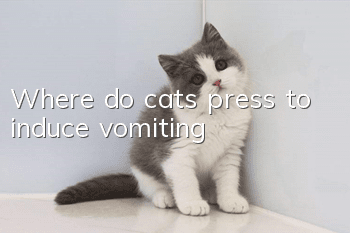How to prevent and control cat plague in spring?

Feline distemper, also known as feline panleukopenia and feline infectious enteritis, is an acute and highly contagious infectious disease of cats. The main clinical manifestations are sudden high fever, intractable vomiting, diarrhea, dehydration, circulatory disorders and a sharp decrease in white blood cells (not all cases of leukopenia are feline plague, other diseases can also cause leukopenia, such as feline leukemia , feline hepatitis, etc.). Cats with incomplete or unvaccinated vaccinations are prone to feline distemper, especially kittens aged 3-5 months. If a female cat is infected during pregnancy, it will cause stillbirth, miscarriage and neurological symptoms in newborn kittens. The infection route is through contact with virus-containing urine and feces or blood-sucking insects and fleas. The pathogen is a virus in the family Parvoviridae and the genus Parvovirus. After the virus enters the body, it can survive in the kidneys for more than 1 year. Parvovirus can survive in the environment for a long time but can be inactivated by formalin, sodium hypochlorite (household disinfectant) or dialdehyde.
The incubation period of feline distemper is 2-9 days, and clinical symptoms are related to age and virus virulence.
Kittens often suffer from acute illness, with body temperature rising above 40°C and vomiting. Many cats do not show any symptoms and die suddenly. Some may show symptoms of spinal ataxia.
Cats over 6 months old mostly present with subacute clinical symptoms. They first have a fever to about 40°C, then drop to normal temperature after 1-2 days, and then rise again after 3-4 days, which is the biphasic fever type.
The sick cat is in low spirits, anorexia, and has stubborn vomiting. The vomit is yellow-green, and there is sticky secretion in the mouth, eyes, and nose, and the feces is sticky. When diarrhea occurs, it means that the animal is in the late stage of the disease, with blood in the feces and severe dehydration. , anemia, severe cases death.
Feline distemper is a common disease in cats. In recent years, many vaccines have been available to help cats prevent such diseases. However, for newborn kittens or cats without immunity, feline distemper is still a very common disease. In spring As the temperature gradually rises, cat plague is also ready to attack.
1. Prevention of cat plague in spring
In recent years, the number of cat lovers in our country has gradually increased, especially those who raise purebred cats. The number of friends who raise purebred cats has increased even more rapidly. A large number of cats are imported to my country from abroad, and some of the cats that enter our country through smuggling channels have not passed through the During quarantine, a considerable number of unhealthy cats came in and seriously threatened domestic cats. This is also the main reason for the frequent occurrence of cat plague in China in recent years.
1. Cat plague is coming
If you find that your cat has a sudden loss of appetite, loose coat, elevated body temperature, vomits yellow-green liquid, diarrhea, sometimes bloody stools, and a foul smell, the owner should be alert at this time. Your cat may have feline plague and take it out immediately. Go to a pet hospital for diagnosis and treatment and conduct a blood test to determine whether it is feline plague.
2. Fighting for cats with cat plague
If discovered early, feline plague may still be cured. In addition to maintaining infusion to ensure the energy and electrolyte balance in the cat's body, injecting feline antiviral serum is the main treatment method in China.
3. Shut out the cat plague
Cat plague is indeed terrible, but it is not impossible to prevent. Feline distemper is mainly transmitted through the digestive tract. The feces, urine and vomit of sick cats contain a large amount of feline distemper virus. The feces of sick cats within several months after recovery contain the virus. Regular vaccination every year is the simplest and most effective way to prevent feline plague.
4. Reminder
If you have more than one cat, and if you find that one of them may be suffering from cat distemper, you should isolate it immediately and thoroughly disinfect the room. Then carefully observe the mental status of the other cats. It is best to consult a pet doctor whether to give other cats Only the serum is injected to fight the virus.
Pregnant female cats have strong resistance. If they suffer from cat plague, the medical solution is to keep the older cats and give up the kittens, because the possibility of such cubs surviving is very low.
Feline distemper vaccine: There are two types: domestic and imported. The domestic feline distemper monoclonal antibody is given to kittens at 3 months of age. Two injections are given, 20-30 days apart, and one injection per year thereafter. Imported cat Sanlian can also be immune to cat plague. When injecting the cat distemper vaccine, you should pay attention to ensuring that the cat is healthy before the injection and do not take a bath within 10 days after the injection.
2. Key points for cat care in spring
1. Spring is the best season for cats to court, mate and reproduce.
Both male and female cats frequently go out and wander around in search of a good mate. Female cats in estrus show restlessness, loss of appetite, some roll on the ground, and make louder than usual meows at night, commonly known as "cat meowing in spring" to attract male cats. Cats that are usually kept at home are often easily lost at this time, and prone to some accidental injuries. Male cats compete for female cats, often causing fights and injuries. Therefore, supervision of cats should be strengthened in spring to prevent cats from escaping. In order to grasp this season of cats and satisfy their desire for mating, cat owners should help cats find mates and conduct purposeful mating. In this way, the cat can be prevented from escaping, lost, and injured, and a more ideal life can be achieved according to the wishes of the cat owner.
2. Spring, when the wind is warm and the sun is warm, is also the season for cats to moult.
Cats shed the thicker winter hair that covers their bodies in winter and replace them with sparser, thin spring hair. In addition, as the temperature gradually warms up, the pores of the cat's skin will open. At this time, the cat should be combed frequently, and attention should be paid to keeping the cat's coat and skin clean.. Otherwise, various microorganisms and ectoparasites will breed and multiply on the cat's skin, causing skin itching and inflammation. In addition, cats shed their coats and dander on their own, especially long-haired cats. Therefore, summer heatstroke is another big threat to cats. For this reason, providing cats with a dry, cool, ventilated living environment without direct sunlight is also an important aspect of daily management of cats. If a cat suddenly becomes ill in the hot summer and has a significantly elevated body temperature, difficulty breathing, a fast and weak pulse, and an unsteady gait, it should be considered whether it is heat stroke. At this time, the cat must be quickly moved to a ventilated and shady place, and the cat's body must be wiped with cold water. Ice cubes or ice packs must be placed on the cat's head. Cold water enema can also be used to help cool down the cat.
- Why do cats sometimes bite people?
- Why do cats sleep with their eyes open?
- What should I do if my cat accidentally eats plastic?
- What food should a kitten with anemia eat?
- Why can't the kitten close its eyes when sleeping?
- Can I buy the super clingy and loyal Siamese cat with folded tail?
- Should I stop my cat from biting the cardboard box?
- Can newborn kittens drink soy milk?
- The "hairless cat" that was once sold for tens of thousands and was robbed is now no one interested?
- Why does the cat keep rolling on the ground?



